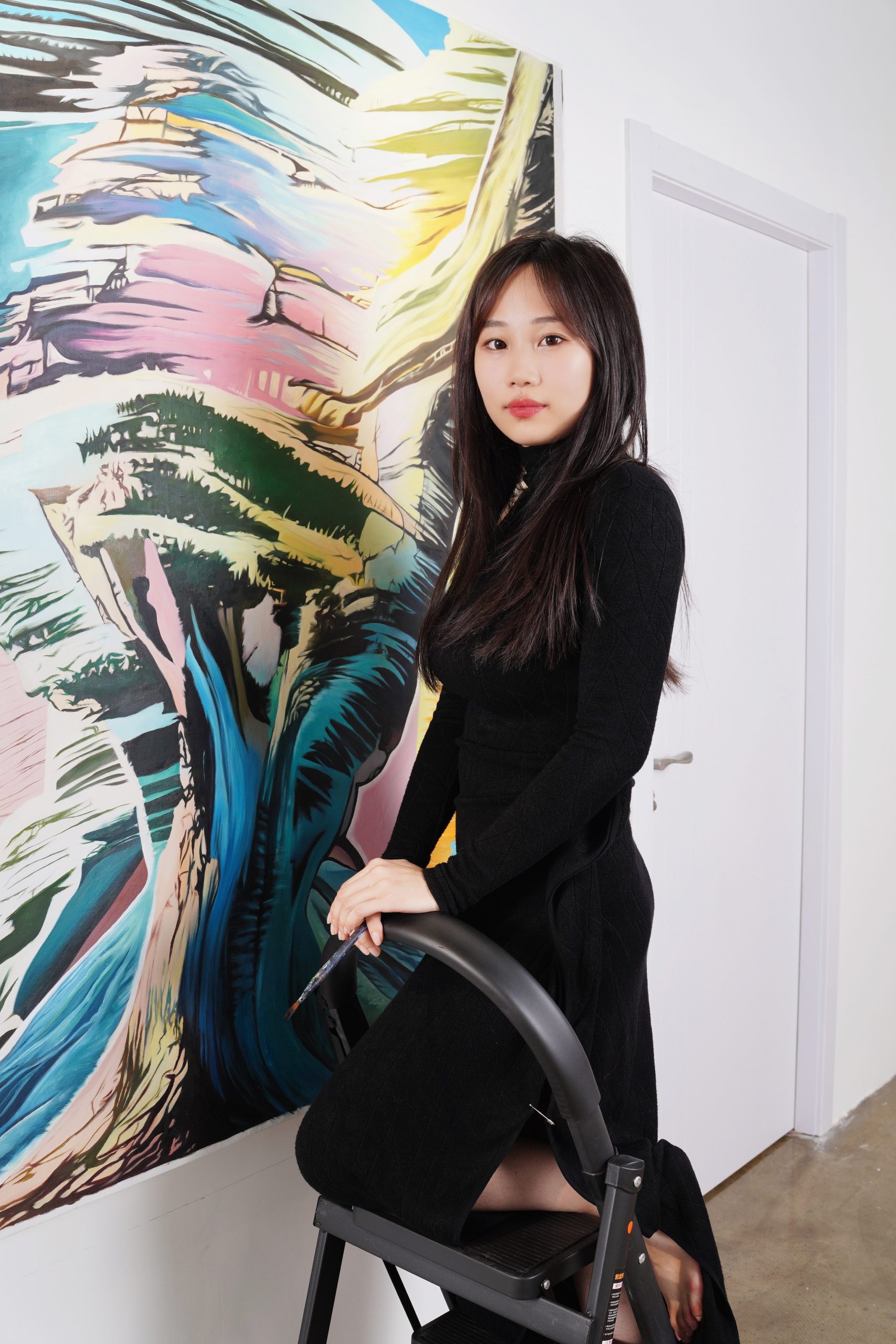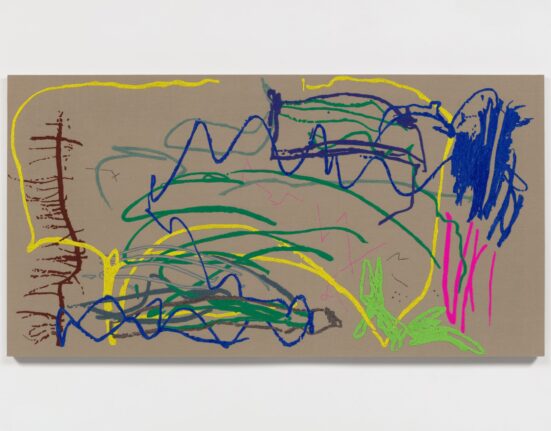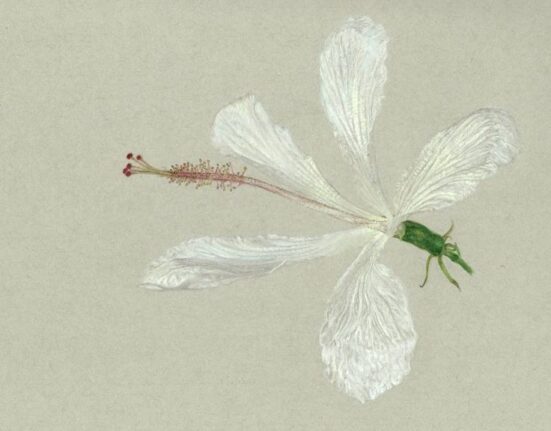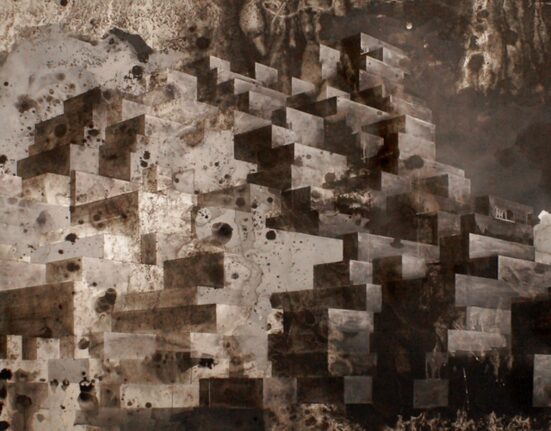Although just a student at the Central Academy of Fine Art, Chinese artist Liane Chu has already developed a multifaceted practice that examines both her own deeply personal lived experiences as well as society’s collective experience in a time of increasing technological development. Crafting poetic paintings full of movement and energy, and building immersive installations that offer a glimpse into a vibrant alternate reality, Chu’s body of work moves seamlessly across boundaries—both thematically and materially.
Central to Chu’s recent lines of artistic inquiry are, at the formal level, the exploration of color and material, and thematically the examination of perception, specifically in light of omnipresent technology and the contemporary world in contrast to the natural.
We caught up with the artist to learn more about how she approaches each of her works and series, as well as where she recurrently finds inspiration.
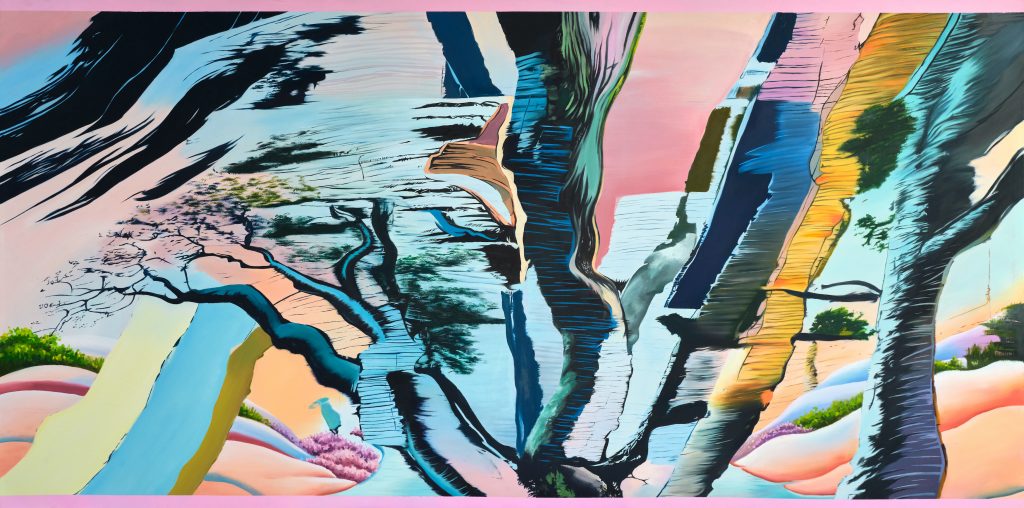
Liane Chu, Look! She’s shining on the magnificent stage (2023). Courtesy of the artist.
Can you tell us a bit about your background, what drove you to pursue art?
My upbringing involved living in different cities and cultural backgrounds, which has given me a diverse cultural identity. I was born in Hong Kong, China, in 1997. I grew up in Shanghai and went to high school in New York, and returned to Hong Kong where I received my B.A. in media and communication from the City University of Hong Kong. Currently, I am pursuing a master’s degree in experimental art and technology at the Central Academy of Fine Arts in Beijing, under the guidance of Qiu Zhijie.
I have Tourette’s syndrome, which causes unintentional tics and seizures. As a child, I saw the world as dynamic, with flowers and trees moving, and mountains and rivers shifting. I only felt at peace when painting, which led me to start communicating with art and to paint the world I saw. Later, my experiences in different cultural backgrounds—in Hong Kong, I studied traditional Chinese painting; while in New York, I delved into abstract painting, and investigated new media and new styles of painting using novel materials. In Florence, Italy, I immersed myself in traditional classical painting and oil painting techniques; and in Spain, I further developed my skills in oil painting. The diverse cultural backgrounds of my art education have broadened my perspective in creating art, allowing me to explore a wider range of themes and use a richer palette of mediums. For example, in my series “Cracks,” I employed the techniques of traditional Chinese ink painting to create works that are both visually arresting and conceptually profound.
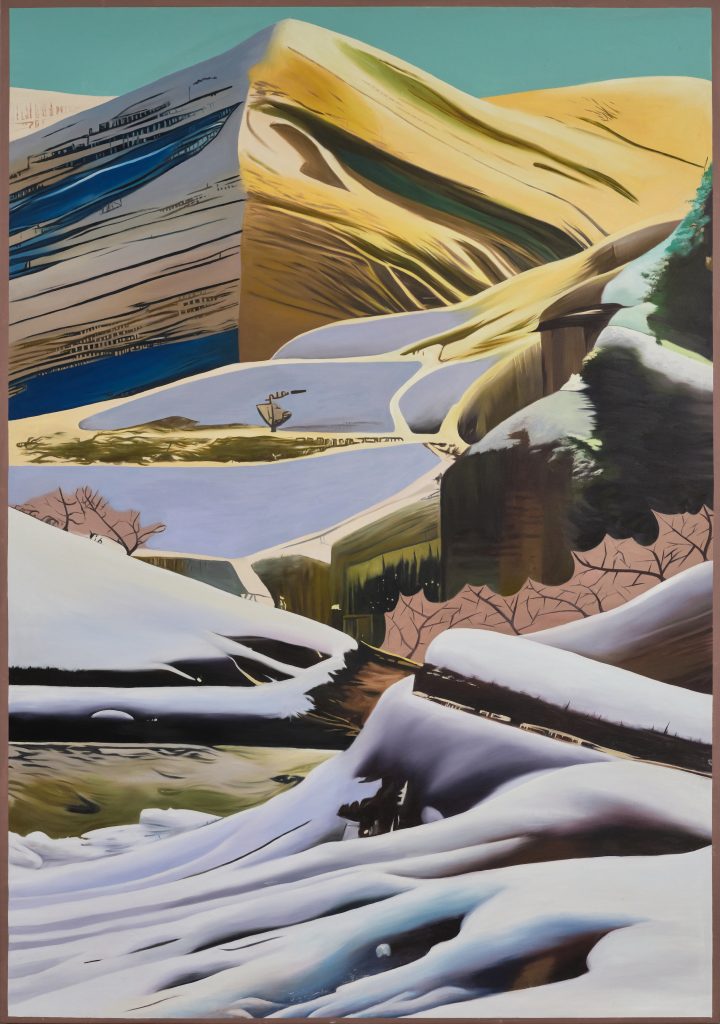
Liane Chu, You will find answers on the mountain top (2023). Courtesy of the artist.
How would you describe your creative process? Is it more regimented, in that you plan everything out ahead of time, or more organic and intuitive?
Both. Before I begin painting, I plan a general theme and direction, but during the creative process, I tend to rely more on my body and emotions. My first series, “Cracks,” can be seen as an extension of traditional Chinese ink painting. In the process of creating this series, I used my Tourette syndrome to stimulate the release of physical strength and express emotions. My second series, “Normal and Abnormal,” reflects on the current social and technological era. In real life, people are addicted to online media, accustomed to watching content that is framed within electronic devices. Unevenly filtered information is often pushed to people’s faces by big data, seemingly giving them the choice of information, but in reality, they have lost their autonomy. The mechanical glitch-like depiction of trees and natural scenery in the paintings is my projection of physical tremors caused by Tourette syndrome.
How do your practices of painting, sculpture, and installation inform or influence each other? Or do you approach them as distinct from one another?
My latest series, “Normal and Abnormal,” delves into the ideas of what is considered “normal” and “abnormal.” My artworks often focus on nature, emphasizing trees and mountains in extraordinary and extreme landscapes. For instance, my installation at Beijing SKPS was inspired by my painting Normal and Abnormal. I took this concept a step further by utilizing materials like sand, artificial lights, tree sculptures, acrylic paint, stickers, and other materials to create a captivating visual experience.
By growing the trees in darkness and emerging from the sand, they appear disconnected and separate from each other, yet placed in a seemingly normal context, prompting deeper reflections. The use of avant-garde and cyberpunk colors highlights the trees’s odd colors and appearance in this abnormal natural setting—much like the relationship between social media and people today. Inappropriate content can have negative impacts on viewers, and over time, people’s ability to distinguish right from wrong, good from bad, can be corrupted.
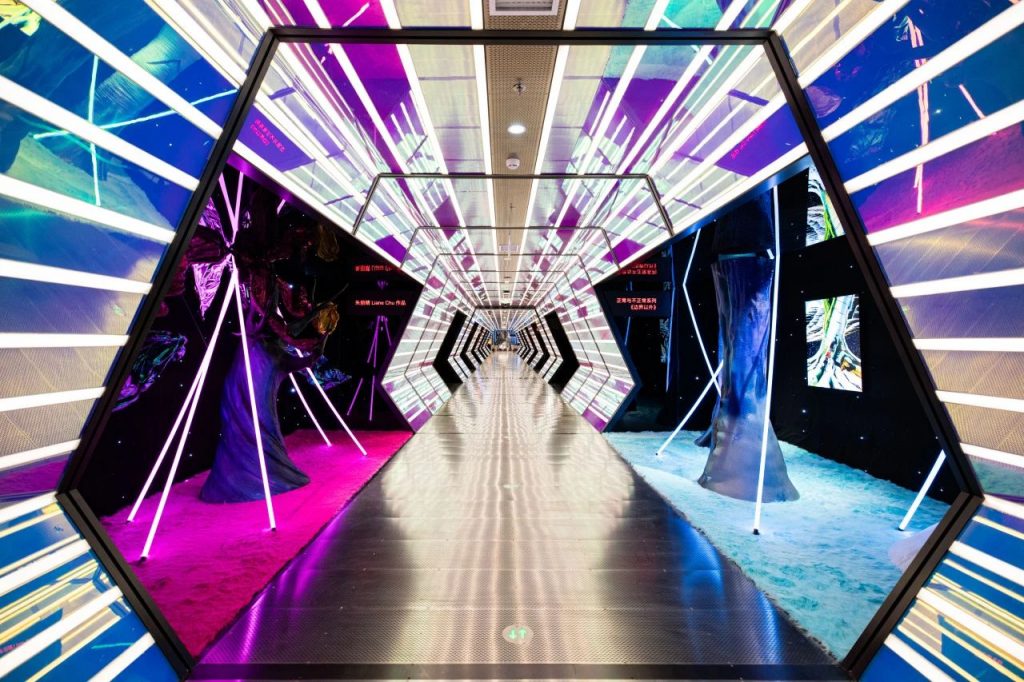
Installation view of “Liane Chu: Beyond Boundaries” (2023/24). Courtesy of the artist.
Where do you most commonly look for or find inspiration?
I will go to the world around me to seek unique and abnormal landscapes. For example, I once went to Wulanchi Lake in the Tengger Desert in China to sketch and seek inspiration from nature. Wulanchi Lake is also known as the heart of the Earth. The lake has a heart-shaped and intense red color. Therefore, I was overwhelmed by the wonders of nature and created Heart of the Earth, one of the pieces from “Cracks.”
How does technology and/or the state of the Information Age influence your work?
“Normal and Abnormal” was created against the backdrop of the Information Age. In this era of the internet explosion, electronic products, and their information are influencing the thinking of young people to varying degrees. The frames I draw around the canvas and the flash screens in my works symbolize electronic screens such as phones and televisions. The online world within these screens also has its own definitions of normal and abnormal. The information on these screens subtly affects people’s values. While people may seem to have the upper hand and the ability to actively view content, there are invisible frameworks and barriers between the screen and the audience. People are passively receiving the informational baptism of the media, and if they don’t discriminate, they may easily fall into the trap of “abnormality.” My different study abroad experiences in Hong Kong, Shanghai, and New York have given me different perspectives on things. My life is also influenced by online information, which led me to create this new series as a form of self-reflection.

Installation view of “Liane Chu: Beyond Boundaries” (2023/24). Courtesy of the artist.
Can you discuss your considerations and use of “normal” and “abnormal” dichotomies in your work?
I often reflect on my own Tourette’s syndrome. As a sufferer of Tourette’s syndrome, I have higher levels of the natural body substances adrenaline, oxytocin, and dopamine than the average person, leading to neurological imbalances that make me more prone to happiness and excitement. This, in turn, results in my having heightened creativity.
Often, what is classified as normal is based on norms, beliefs, and habits. Anything that falls outside of these accepted understandings is considered abnormal. However, as French philosopher Michel Foucault and his teacher Georges Canguilhem pointed out, there was no such thing as normal and abnormal before the modern industrial society. Instead, there was only health and illness. It is the current information age that has changed our understanding of what is normal and abnormal. In fact, there is no such thing as abnormal in the world. We should respect different cultures and traditions, understand differences, and respect individuality.
Can you tell us what you are currently working on, or what you are planning to work on next?
I’m currently gearing up for several exhibitions in 2024. In mid-March, I’ll be collaborating with Seefoodroom for a solo exhibition at Art Central in Hong Kong. In June, I’ll be showcasing my work at K11 in Guangzhou for another solo exhibition. In the middle of June, I’ll be participating in a group exhibition at Paris’s Galerie Dumonteil. In September, I’ll be presenting my work at the highly renowned Long Story Short in New York for a personal project. And finally, in December, I’ll be exhibiting at Galerie Dumonteil in Shanghai for another solo exhibition.
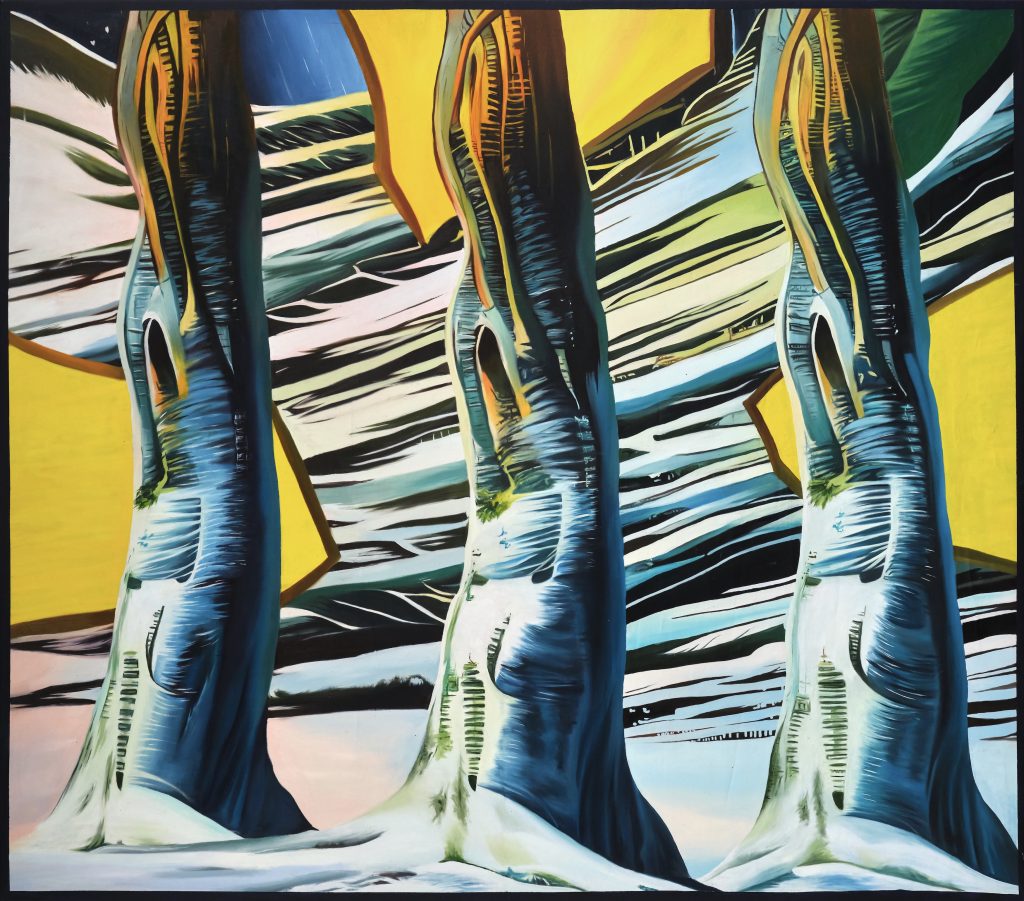
Liane Chu, Midnight Trio (2023). Courtesy of the artist.
Follow Artnet News on Facebook:
Want to stay ahead of the art world? Subscribe to our newsletter to get the breaking news, eye-opening interviews, and incisive critical takes that drive the conversation forward.

